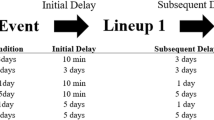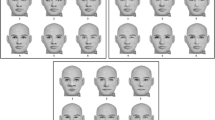Abstract
Experiment 1 tested one-person and six-person photographic lineup identifications in field situations either immediately, or 30 minutes, or 2 hours, or 24 hours after a 15-second ordinary encounter with a target. Accuracy of performance was superior in six-person lineups than in showups over time. False identifications of a lookalike innocent suspect were significantly greater in showups than in six-person lineups, especially when the suspect wore the same clothing as the culprit. Experiment 2 followed the same research design as Experiment 1, except that only live showup identifications were tested and, in addition, a physically dissimilar innocent suspect was shown to witnesses. The dissimilar innocent suspect was consistently and correctly rejected in the target-absent showup. Hit rates for live suspects were relatively low over the 24-h retention interval. Correct rejections significantly exceeded false identifications only on the immediate test. The lookalike innocent suspect was readily rejected when different clothing was worn at the test. No significant differences were found in hit scores or in confidence-accuracy scores between live and photographic targets. Confidence-accuracy correlations were significant but low across experimental conditions.
Similar content being viewed by others
References
Bothwell, R. K., Deffenbacher, K. A., & Brigham, J. C. (1987). Correlation of eyewitness accuracy and confidence: Optimality hypothesis revisited.Journal of Applied Psychology, 72, 691–695.
Brigham, J. C., & Pfeifer, J. E. (1994). Evaluating the fairness of lineups. In D. F. Ross, J. D. Read, & M. P. Toglia (Eds.),Adult eyewitness testimony: Current trends and developments (pp. 201–222). New York: Cambridge University Press.
Brooks, N. (1983).Police guidelines: Pretrial eyewitness identification procedures. Ottawa: Law Reform Commission of Canada.
Cutler, B. L., & Fisher, R. P. (1990). Live lineups, videotaped lineups, and photoarrays.Forensic Reports, 3, 439–448.
Gonzalez, R., Ellsworth, P. C., & Pembroke, M. (1993). Response biases in lineups and showups.Journal of Personality and Social Psychology, 64, 525–537.
Grano, J. D. (1984). A legal response to the inherent dangers of eyewitness identification testimony. In G. L. Wells & E. F. Loftus (Eds.),Eyewitness testimony: Psychological perspectives (pp. 315–335). Cambridge: Cambridge University Press.
Kassin, S. M., Ellsworth, P. C., & Smith, V. L. (1989). The “general acceptance” of psychological research on eyewitness testimony: A survey of the experts.American Psychologist, 46, 1089–1098.
Lindsay, R. C. L., & Harvie, V. (1988). Hits, false alarms, correct and mistaken identifications: The effects of method of data collection on facial memory. In M. Gruneberg, P. Morris, & R. Sykes (Eds.),Practical aspects of memory: Current research and issues: Current research and issues, Vol. 1:Memory in everyday life (pp. 47–52). Chichester: Wiley.
Lindsay, R. C. L., Lea, J. A., & Fulford, J. A. (1991). Sequential lineup presentation: Technique matters.Journal of Applied Psychology, 76, 741–745.
Lindsay, R. C. L., Wallbridge, H., & Drennan, D. (1987). Do the clothes make the man?: An exploration of the effect of lineup attire on eyewitness identification accuracy.Canadian Journal of Behavioural Science, 19, 463–478.
Lindsay, R. C. L., & Wells, G. L. (1985). Improving eyewitness identifications from lineups: Simultaneous versus sequential lineup presentation.Journal of Applied Psychology, 70, 556–564.
Luus, C. A., & Wells, G. L. (1994). Eyewitness identification and confidence. In D. F. Ross, J. D. Read, & M. P. Toglia (Eds.),Adult eyewitness testimony: Current trends and developments (pp. 348–361). New York: Cambridge University Press.
People v. Brnja, 70 A.D.2d 17, 419 N.Y.S.2d 591 (1979), aff'd, 50 N.Y.2d 366, 40 N.E.2d 1066, 429 N.Y.S.2d 173 (1980).
Read, J. D. (1995, July).Confidence and accuracy in eyewitness studies: Is the conclusion changing? Paper presented at the first biennial meeting of the Society for Applied Research in Memory and Cognition, Vancouver, B.C.
Singletary v. United States, 383 A.2d 1064(D.C.1978).
Wagenaar, W. A., & Veefkind, N. (1992). Comparisons of one-person and many-person lineups: A warning against unsafe practices. In F. Losel, D. Bender, & T. Bliesener (Eds.),Psychology and law: International perspectives (pp. 275–285). Berlin: de Gruyter.
Wells, G. L., & Lindsay, R. C. L. (1980). On estimating the diagnosticity of eyewitness nonidentifications.Psychological Bulletin, 99, 320–329.
Wells, G. L., & Lindsay, R. C. L. (1985). Methodological notes on the confidence-accuracy relationship in eyewitness identifications.Journal of Applied Psychology, 70, 413–419.
Wells, G. L., Seelau, E. P., Rydell, S. M., & Luus, C. A. E. (1994). Recommendations for properly conducted lineup identification tasks. In D. F. Ross, J. D. Read, & M. P. Toglia (Eds.),Adult eyewitness testimony: Current trends and developments (pp. 223–244). New York: Cambridge University Press.
Yarmey, A. D. (1994). Earwitness evidence: Memory for a perpetrator's voice. In D. F. Ross, J. D. Read, & M. P. Toglia (Eds.),Adult eyewitness testimony: Current trends and developments (pp. 101–124). New York: Cambridge University Press.
Yarmey, A. D. (1996). The elderly witness. In S. L. Sporer, R. S. Malpass, & G. Koehnken (Eds.),Psychological issues in eyewitness identification (pp. 259–278). Hillsdale, NJ: Erlbaum.
Yarmey, A. D., Yarmey, A. L., & Yarmey, M. J. (1994). Face and voice identifications in showups and lineups.Applied Cognitive Psychology, 8, 453–464.
Yuille, J. C., & Tollestrup, P. A. (1992). A model of the diverse effects of emotion on eyewitness memory. In S.-A. Christianson (Ed.),The handbook of emotion and memory (pp. 201–215). Hillsdale, NJ: Erlbaum.
Author information
Authors and Affiliations
About this article
Cite this article
Yarmey, A.D., Yarmey, M.J. & Yarmey, A.L. Accuracy of eyewitness identifications in showups and lineups. Law Hum Behav 20, 459–477 (1996). https://doi.org/10.1007/BF01498981
Issue Date:
DOI: https://doi.org/10.1007/BF01498981




